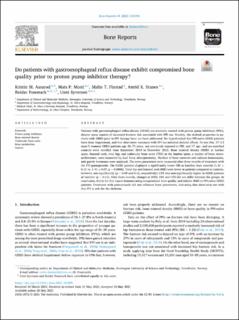| dc.description.abstract | Patients with gastroesophageal reflux disease (GERD) are routinely treated with proton pump inhibitors (PPIs), despite many reports of increased fracture risk associated with PPI use. Notably, the skeletal properties in patients with GERD prior to PPI therapy have not been addressed. We hypothesized that PPI-naïve GERD patients have bone impairment, and that short-term treatment with PPI has minimal skeletal effects. To test this, 17 (12 men/5 women) GERD patients age 32–73 years, not previously exposed to PPI, and 17 age- and sex-matched controls were enrolled from September 2010 to December 2012. Bone mineral density (BMD) at lumbar spine, femoral neck, total hip, and trabecular bone score (TBS) at the lumbar spine, a marker of bone microarchitecture, were measured by dual X-ray absorptiometry. Markers of bone turnover and calcium homeostasis, and gastric hormones were analyzed. The same parameters were measured after three months of treatment with the PPI pantoprazole. The GERD patients displayed a significantly lower TBS at baseline than controls (1.31 ± 0.11 vs. 1.43 ± 0.07, p = 0.0006). Total hip and femoral neck BMD were lower in patients compared to controls, however, not significantly (p = 0.09 and 0.12, respectively). CTX was non-significantly higher in GERD patients at baseline (p = 0.11). After three months, changes in BMD, TBS and CTX did not differ between the groups. In conclusion, this is the first report demonstrating compromised bone quality and inferior BMD in PPI-naïve GERD patients. Treatment with pantoprazole did not influence bone parameters, indicating that short-term use with this PPI is safe for the skeleton | en_US |

